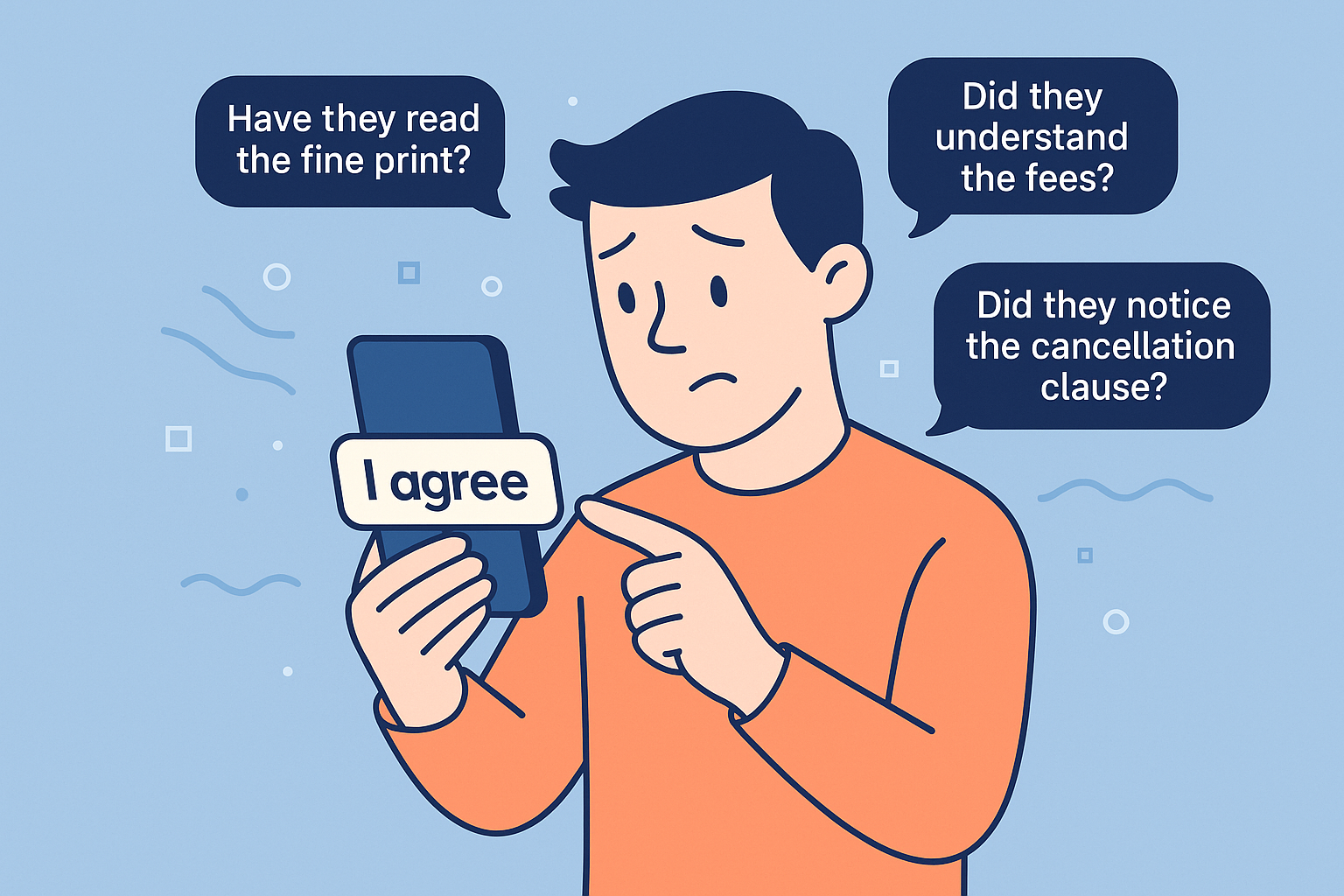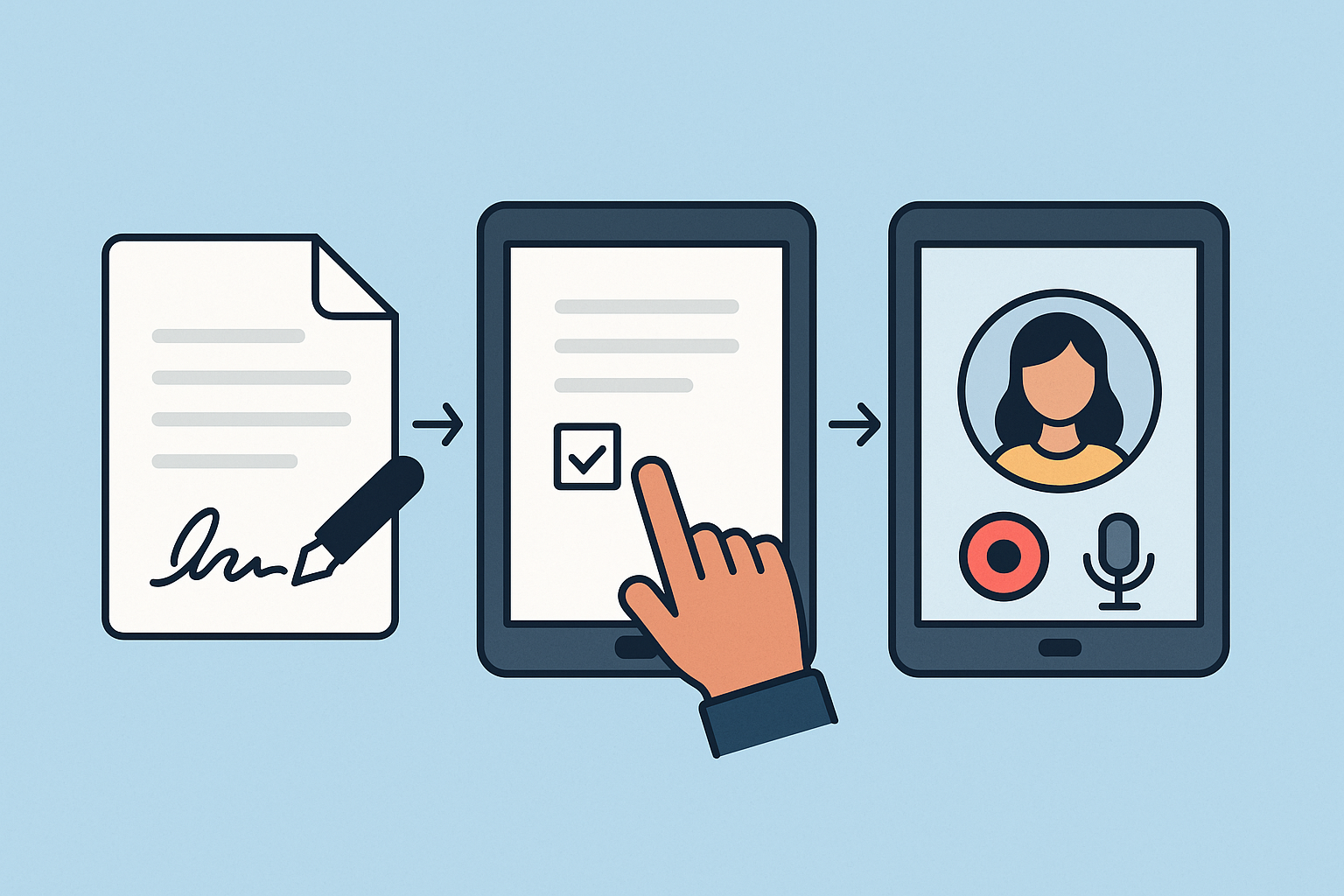 i agree goes beyond signatures to ensure true consent and legal clarity.
i agree goes beyond signatures to ensure true consent and legal clarity.See why companies choose  i agree over DocuSign and Adobe Sign.
i agree over DocuSign and Adobe Sign.

E-signature tools like DocuSign and Adobe Sign serve a purpose: capturing a fast, digital "yes."
But they rely on an outdated assumption — that a signature equals informed consent. In many situations, that simply isn't true.
A signature can’t answer any of those questions. Traditional methods:
| Feature | |
DocuSign | Adobe Sign | HelloSign |
|---|---|---|---|---|
| Ensures understanding |
Yes
|
No
|
No
|
No
|
| Informed consent, not just signature |
Yes
|
No
|
No
|
No
|
| Works without traditional signature |
Yes
|
No
|
No
|
No
|
| Use video & plain language |
Yes
|
No
|
No
|
No
|
| Handle questions before agreement |
Limited
|
Limited
|
Limited
|
Limited
|
| Photo verification |
Yes
|
No
|
No
|
No
|
| Full audit trail |
Limited
|
Limited
|
Limited
|
Limited
|

Traditional signatures are a poor measure of understanding. They can be forged, skipped, misunderstood — or worse, completed without even reading the document. In regulated industries, that’s a real liability.
Each action is timestamped and recorded, creating a rich audit trail that proves how consent was given, not just when. This makes compliance easier, disputes less likely, and trust stronger.
| Use case | Why |
|---|---|
| Consumer agreements | Present information in a way consumers can understand |
| Regulated financial products | Meet informed consent obligations and FCA consumer duty guidance |
| Vulnerable customers | Simplified formats that are the same for everyone |
| High-dispute environments | Reduce “I don't understand” claims with audit trail of every component of the informed decision |
Plain-language summaries to reduce legalese
Short explainer videos to bring terms to life
Highlighting and repetition of key points
Interactive prompts to confirm the consumers agreement
You can’t do that in DocuSign — but you can in ![]() i agree
i agree
It’s built by solicitors
It’s backed by behavioural science, not just tech trends
It aligns with case law and regulatory guidance
It adds zero friction to your current process — but drastically improves the outcomes
It builds trust with consumers
![]() i agree is a UK-based platform that goes beyond traditional e-signature tools like DocuSign. Instead of focusing on collecting signatures, we capture informed consent through video, audio, and clear explanations. It's designed specifically for regulated industries where understanding matters.
i agree is a UK-based platform that goes beyond traditional e-signature tools like DocuSign. Instead of focusing on collecting signatures, we capture informed consent through video, audio, and clear explanations. It's designed specifically for regulated industries where understanding matters.
Yes. Consent doesn’t have to be captured with a signature to be legally binding. ![]() i agree complies with UK laws, eIDAS, and other relevant frameworks by recording auditable actions like voice confirmation and video explainers that prove intent and understanding.
i agree complies with UK laws, eIDAS, and other relevant frameworks by recording auditable actions like voice confirmation and video explainers that prove intent and understanding.
While most tools focus on speed and simplicity, ![]() i agree focuses on clarity and comprehension. We offer explainers, voice/video confirmations, and audit trails that show the user understood the key terms — not just that they clicked “Sign.”
i agree focuses on clarity and comprehension. We offer explainers, voice/video confirmations, and audit trails that show the user understood the key terms — not just that they clicked “Sign.”
Absolutely. ![]() i agree is built with UK compliance in mind — including FCA and SRA-regulated sectors. We provide defensible consent records that help firms meet their obligations around transparency and client understanding.
i agree is built with UK compliance in mind — including FCA and SRA-regulated sectors. We provide defensible consent records that help firms meet their obligations around transparency and client understanding.
Yes. ![]() i agree is a complete alternative to tools like HelloSign and Adobe Sign — especially if your priority is ensuring the client actually understands what they’re agreeing to. We’re ideal for firms that need more than just a quick tick box.
i agree is a complete alternative to tools like HelloSign and Adobe Sign — especially if your priority is ensuring the client actually understands what they’re agreeing to. We’re ideal for firms that need more than just a quick tick box.
Yes. Our platform includes API access (available with higher licence tiers) and can be integrated into your workflows or CRM. We’re happy to work with your tech team to ensure smooth adoption.
If you have more questions, take a look at our full FAQs page where we cover a wider range of topics in more detail. It’s a quick way to find answers and explore other subjects that might be useful to you.


